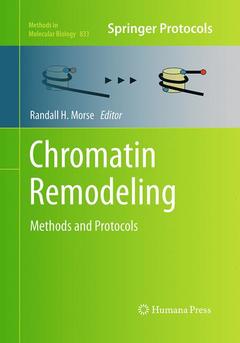Description
Chromatin Remodeling, Softcover reprint of the original 1st ed. 2012
Methods and Protocols
Methods in Molecular Biology Series, Vol. 833
Coordinator: Morse Randall H.
Language: English
Publication date: 08-2016
Support: Print on demand
Publication date: 12-2011
456 p. · 17.8x25.4 cm · Paperback
Description
/li>Contents
/li>Comment
/li>
Chromatin is of central importance to gene regulation in eukaryotes. Reflecting this singular role for chromatin, numerous approaches have evolved in the laboratory over the past three decades to study chromatin structure and its alterations. Methods of investigating chromatin remodeling, whether in changes in nucleosome structure or position with respect to the incorporated DNA or in histone modifications, have progressed rapidly over the recent years. In Chromatin Remodeling: Methods and Protocols, expert researchers contribute chapters which include methods for investigating chromatin remodeling in vitro and in vivo, in yeast, plants, and mammalian cells, and at local and global levels. Both gene-specific and genome-wide approaches are covered, and in recognition of the increasing prevalence of the latter type of study, the final two chapters focus on bioinformatic/computational approaches to analyzing genome-wide data on chromatin structure. Written in the highly successful Methods in Molecular Biology? series format, the chapters include introductions to their respective topics, lists of the necessary materials and reagents, step-by-step, readily reproducible laboratory protocols, and tips on troubleshooting and avoiding known pitfalls.
Comprehensive and essential, Chromatin Remodeling: Methods and Protocols serves as a key source of clear techniques as well as a collection of chapters that can inspire future techniques in this vital field of study.
Strain Construction and Screening Methods for a Yeast Histone H3/H4 Mutant Library.- Measuring Dynamic Changes in Histone Modifications and Nucleosome Density during Activated Transcription in Budding Yeast.- Monitoring the Effects of Chromatin Remodelers on Long-Range Interactions In Vivo.- Measuring Nucleosome Occupancy In Vivo by Micrococcal Nuclease.- Analysis of Nucleosome Positioning Using a Nucleosome-Scanning Assay (NuSA).- Assaying Chromatin Structure and Remodeling by Restriction Enzyme Accessibility.- Generation of DNA Circles in Yeast by Inducible Site-Specific Recombination.- An Efficient Purification System for Native Minichromosome from S. cerevisiae.- Simultaneous, Single-Molecule Detection of Endogenous C-5 DNA Methylation and Chromatin Accessibility Using MAPit.- Analysis of Stable and Transient Protein-Protein Interactions.- Monitoring Dynamic Binding of Chromatin Proteins In Vivo by Fluorescence Recovery after Photobleaching (FRAP).- Monitoring Dynamic Binding of Chromatin Proteins In Vivo by Fluorescence Correlation Spectroscopy (FCS) and Temporal Image Correlation Spectroscopy (TICS).- Analysis of Chromatin Structure in Plant Cells.- Analysis of Histones and Histone Variants in Plants.- Reconstitution of Modified Chromatin Templates for In Vitro Functional Assays.- A Defined In Vitro System to Study ATP-Dependent Remodeling of Short Chromatin Fibers.- In Vitro Reconstitution of In Vivo-Like Nucleosome Positioning on Yeast DNA.- Activator-Dependent Acetylation of Chromatin Model Systems.- Mapping Assembly-Favored and Remodeled Nucleosome Positions on Polynucleosomal Templates.- Analysis of Changes in Nucleosome Conformation Using Fluorescence Resonance Energy Transfer (FRET).- Preparation of Nucleosomes Containing a Specific H2A-H2A Crosslink Forming a DNA-Constraining Loop Structure.- Sulfyhydryl Reactive Site-Directed Crosslinking as a Method for Probing the Tetrameric Structure of Histones H3 and H4.- Genomic Approaches for Determining Nucleosome Occupancy in Yeast.- Genome-Wide Approaches to Determining Nucleosome Occupancy in Metazoans Using MNase-Seq.- Salt Fractionation of Nucleosomes for Genome-Wide Profiling.- Quantitative Analysis of Genome-Wide Chromatin Remodeling.- Computational Analysis of Nucleosome Positioning.
These books may interest you

Chromatin Protocols 105.49 €



